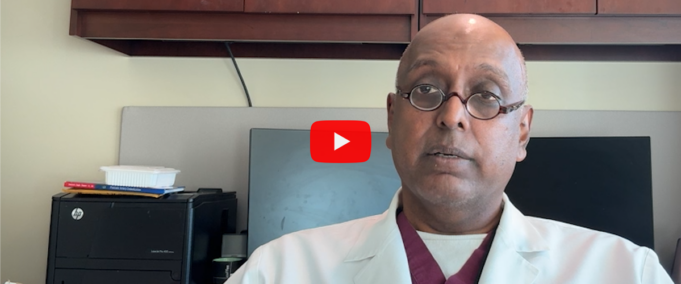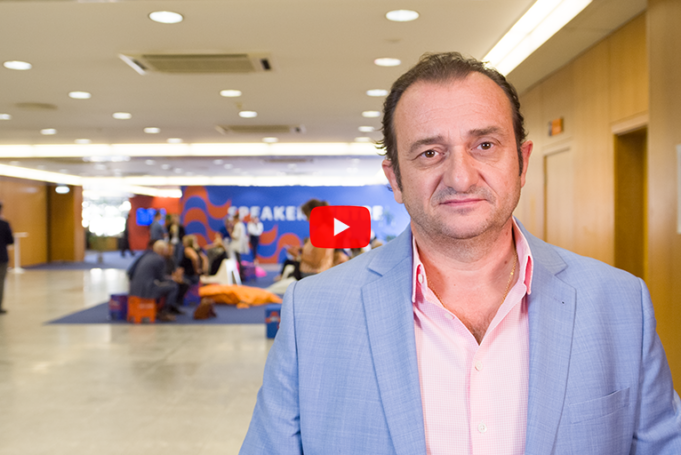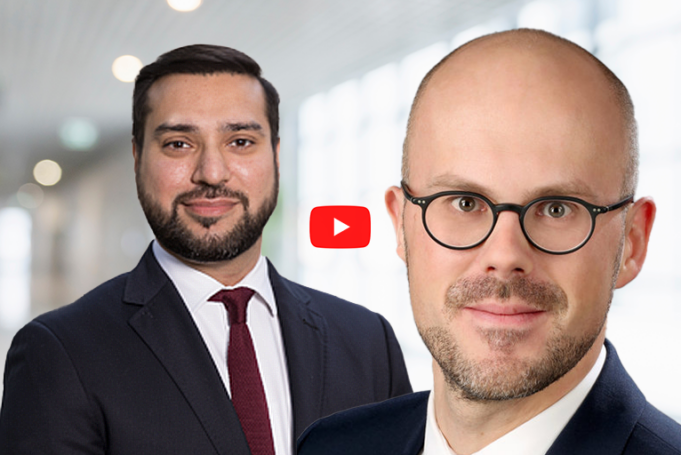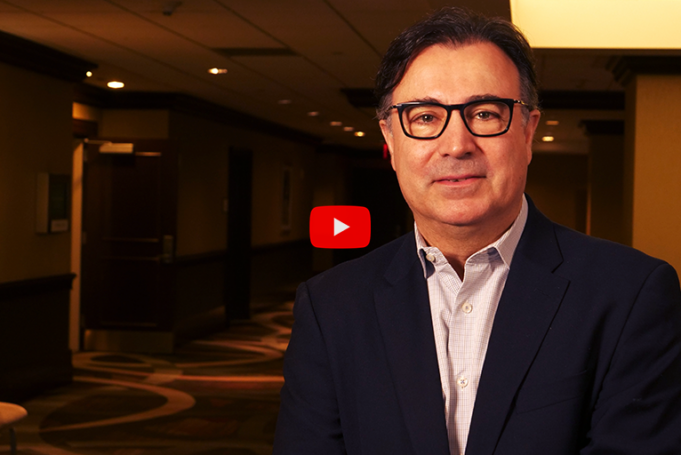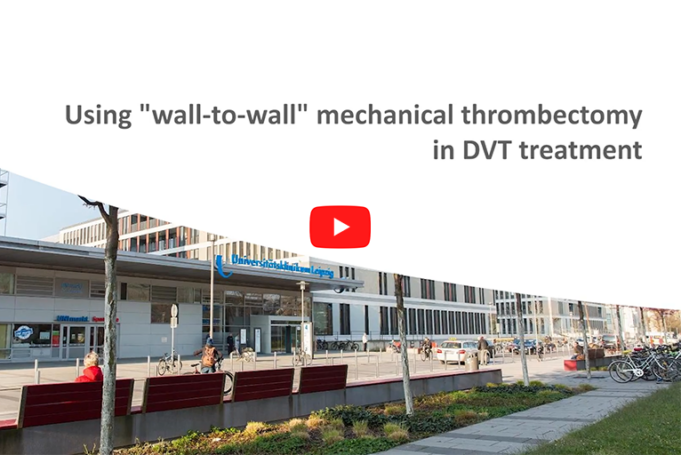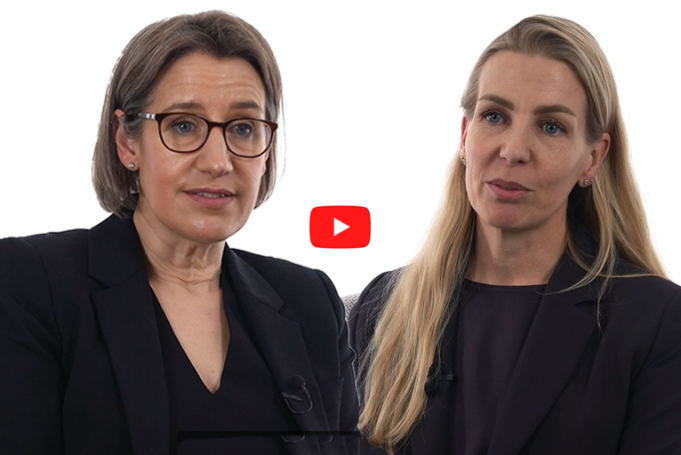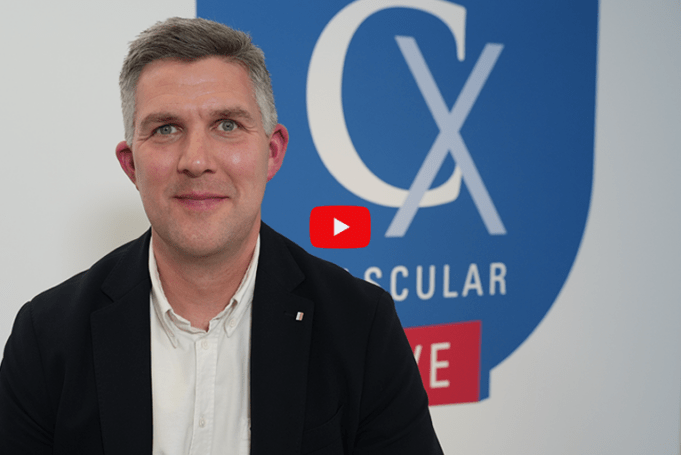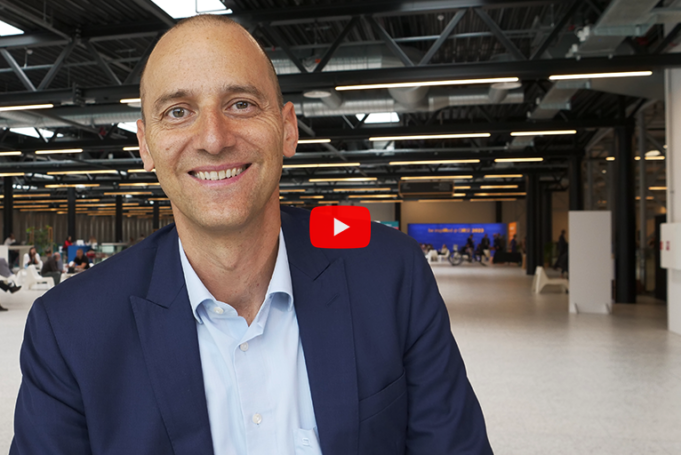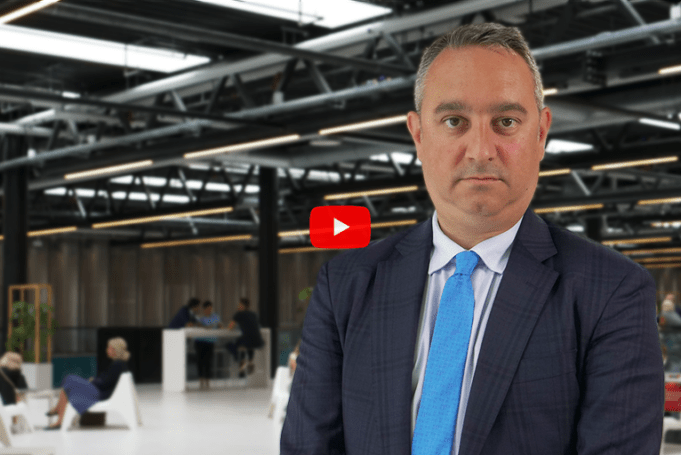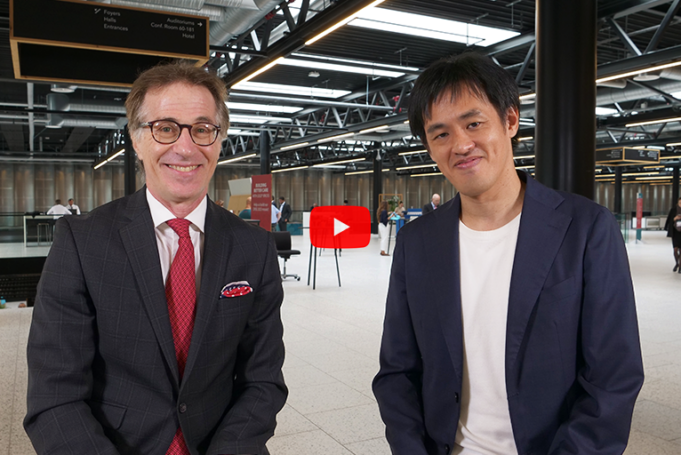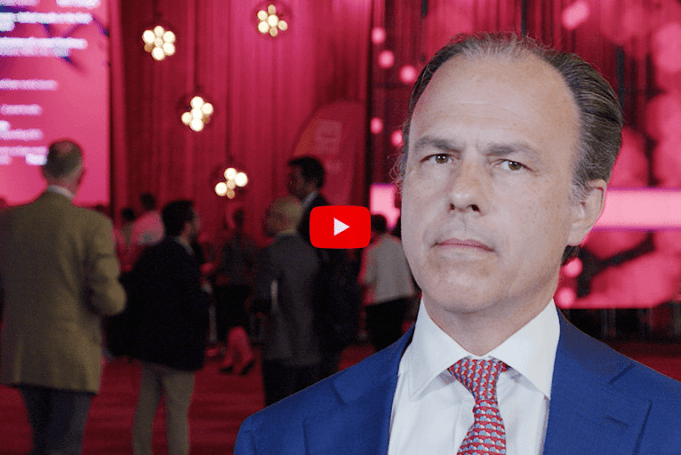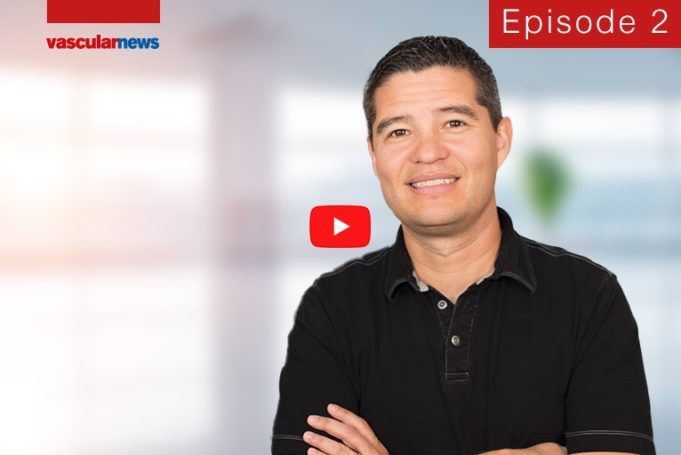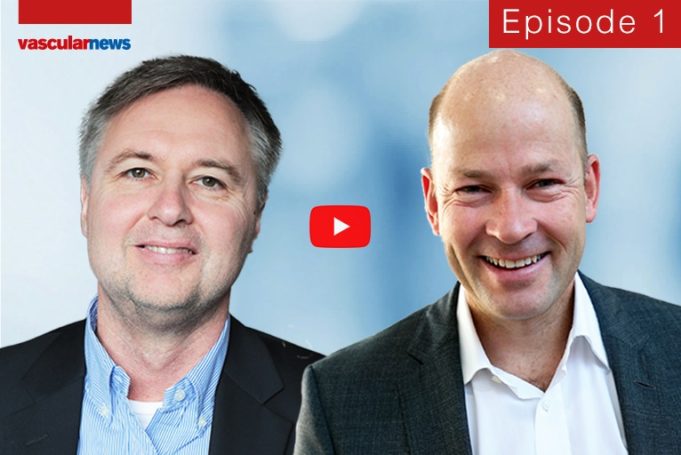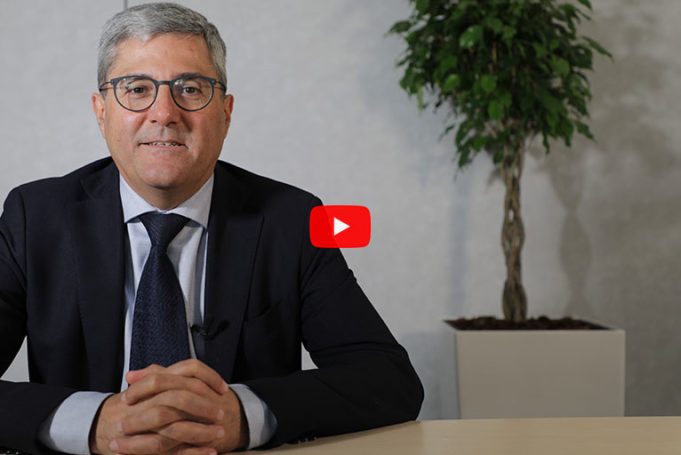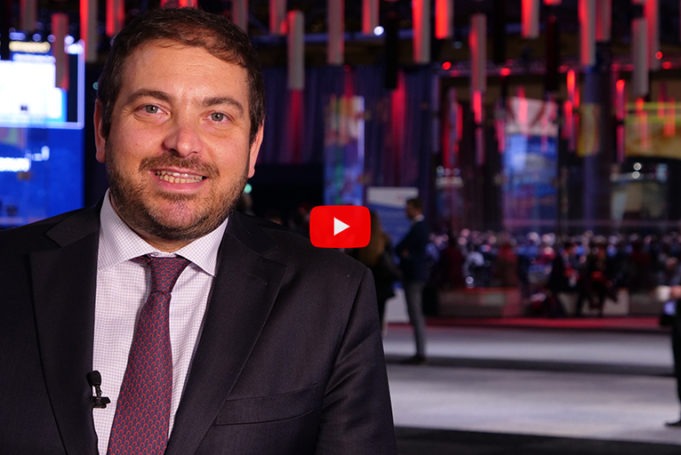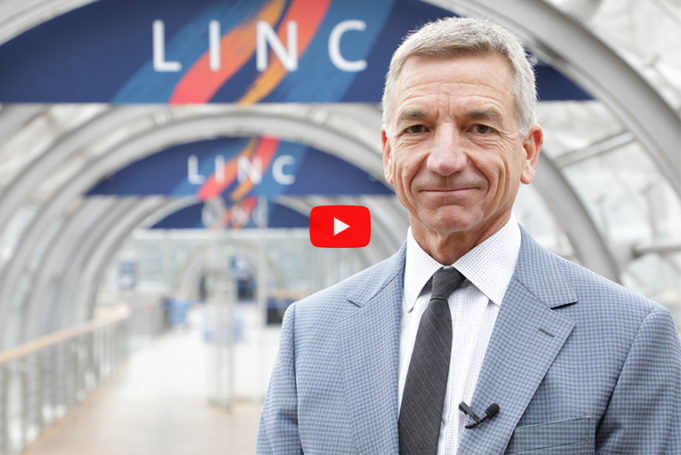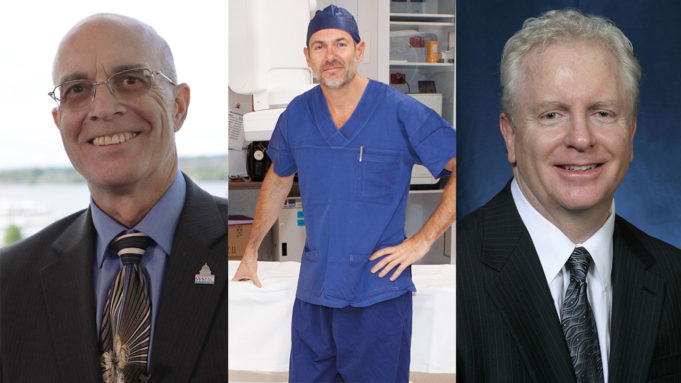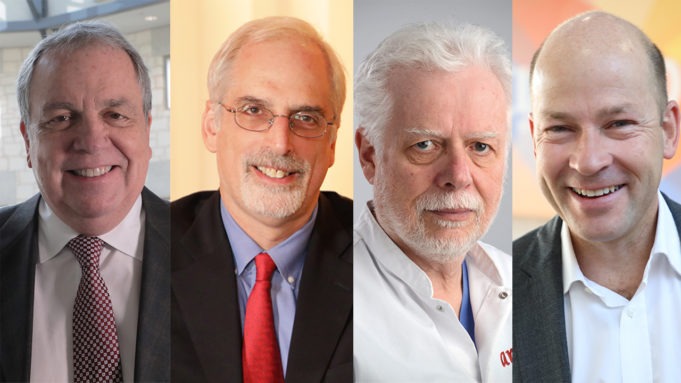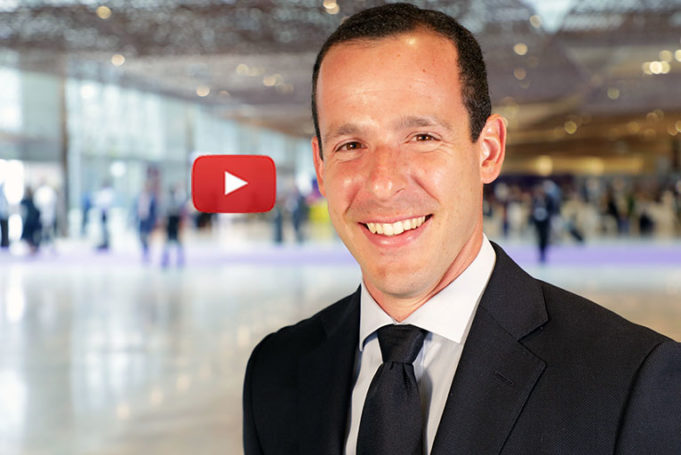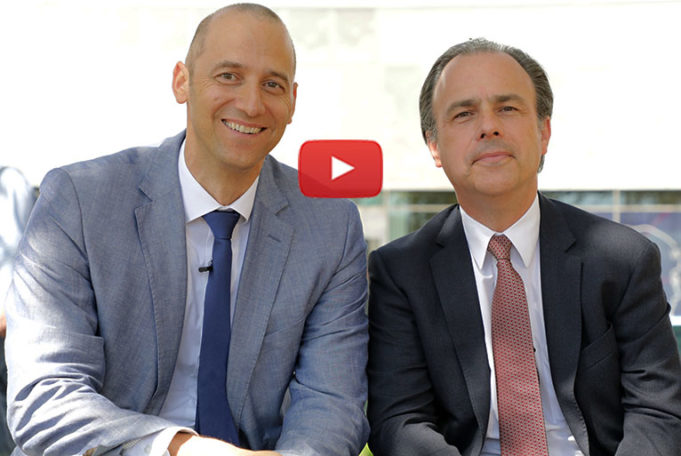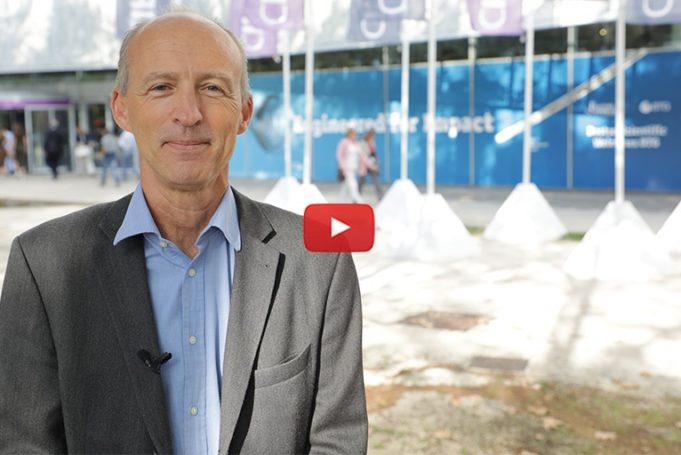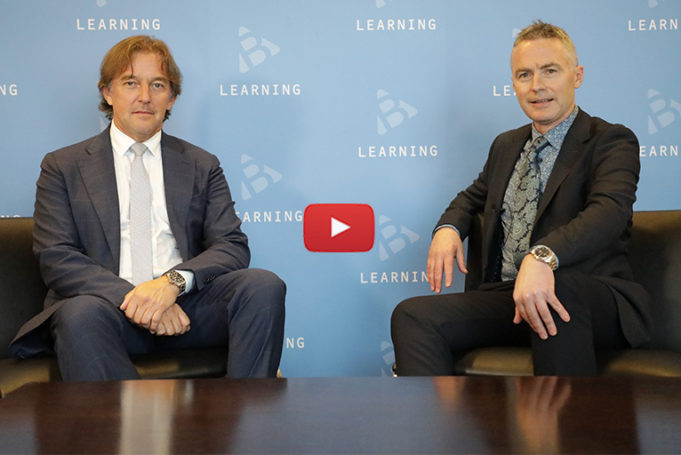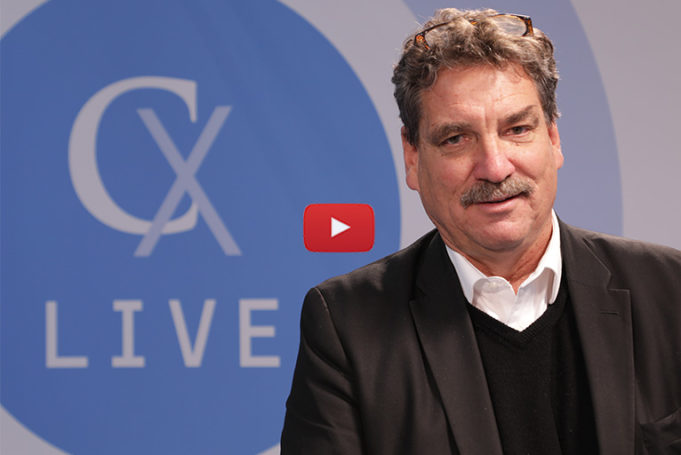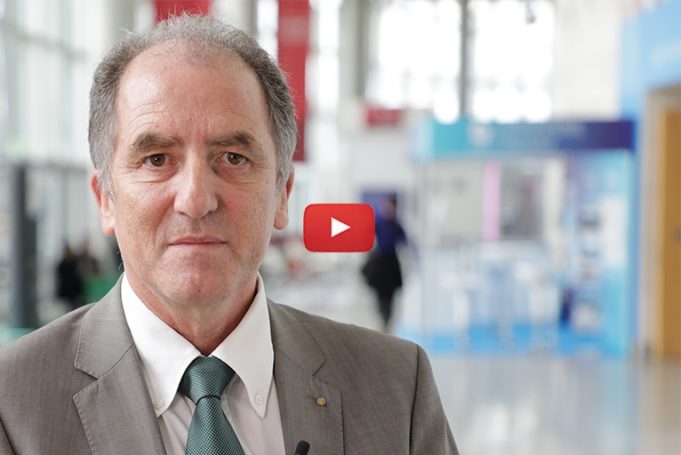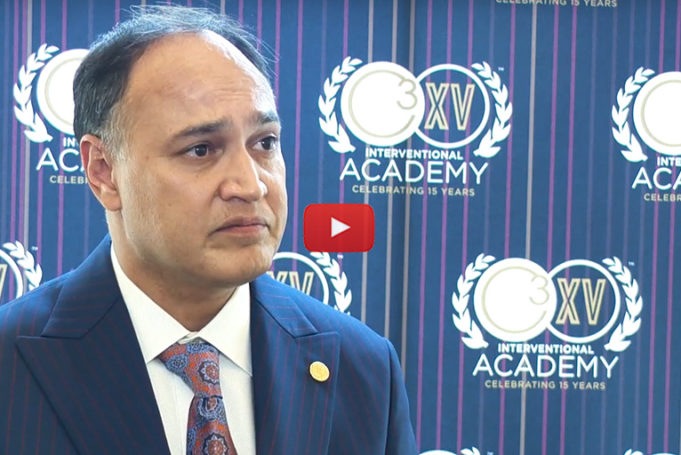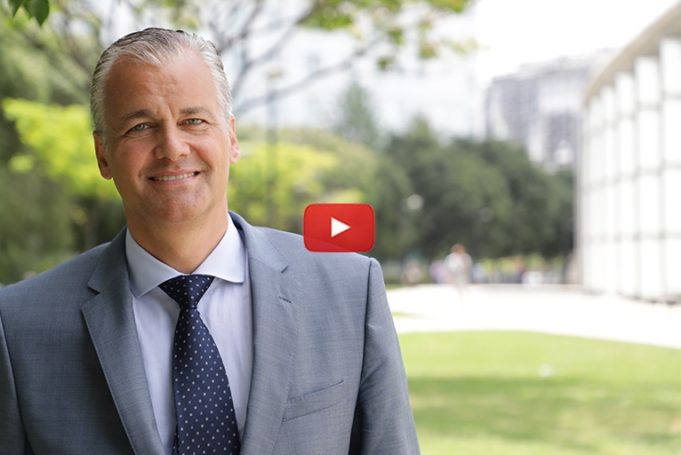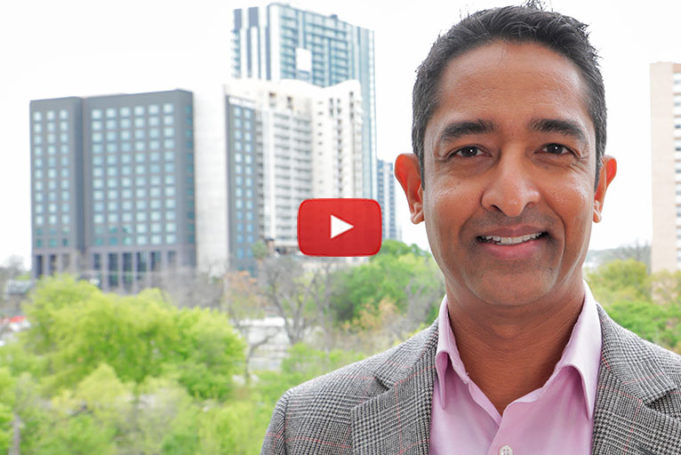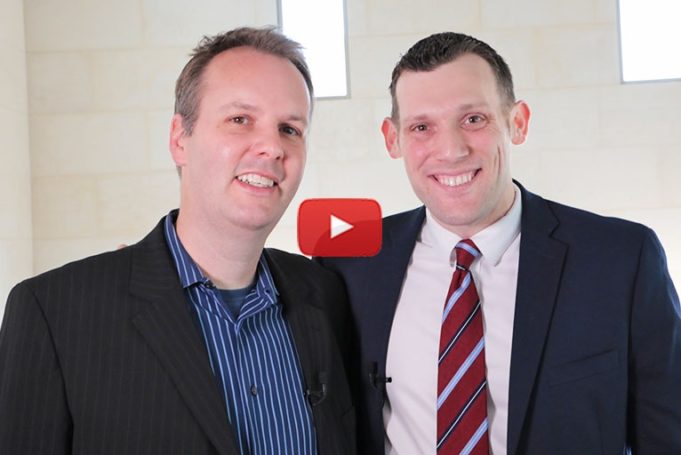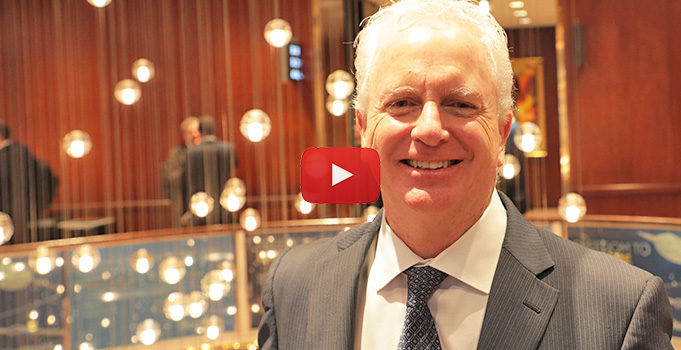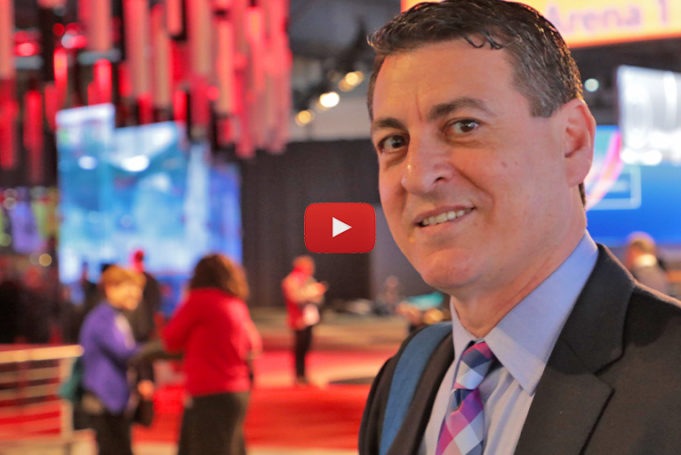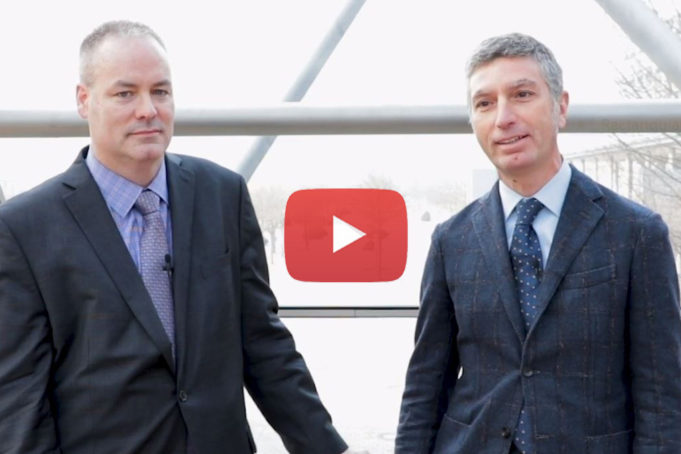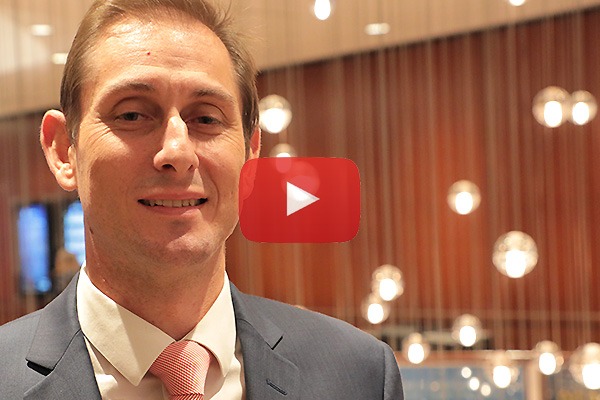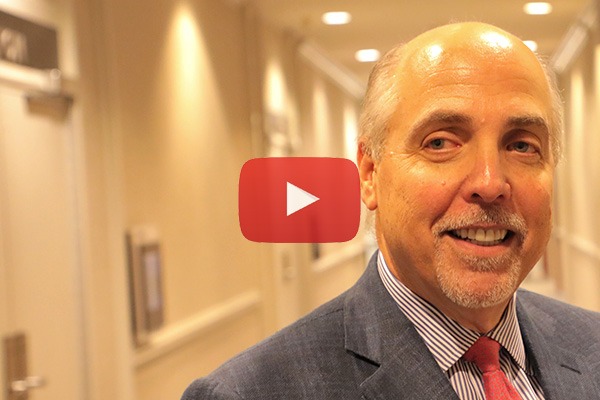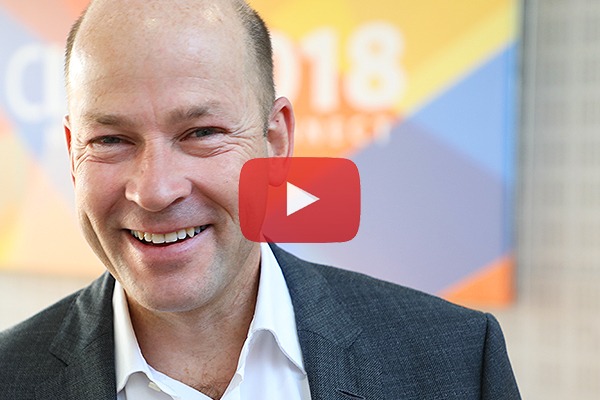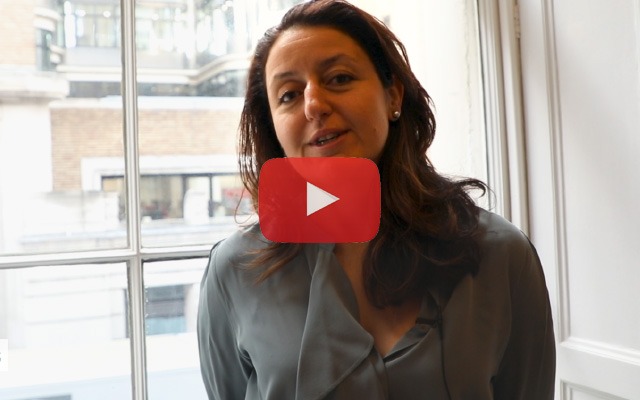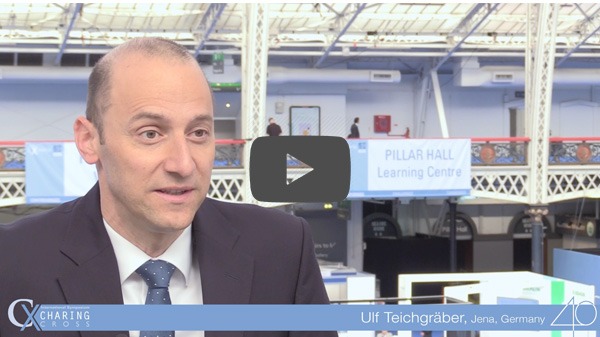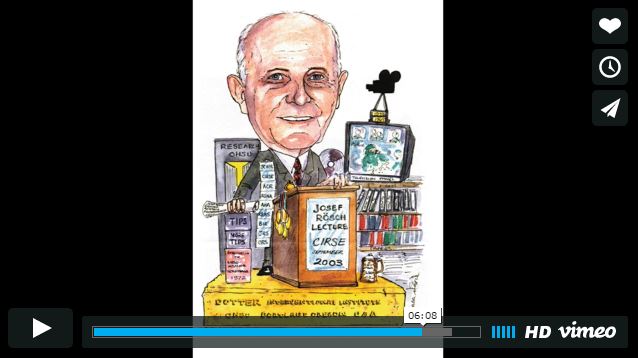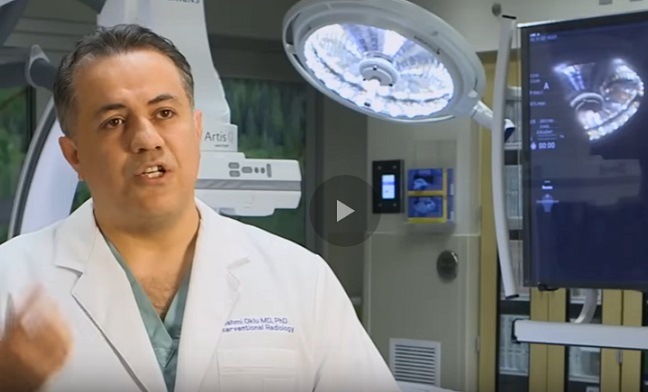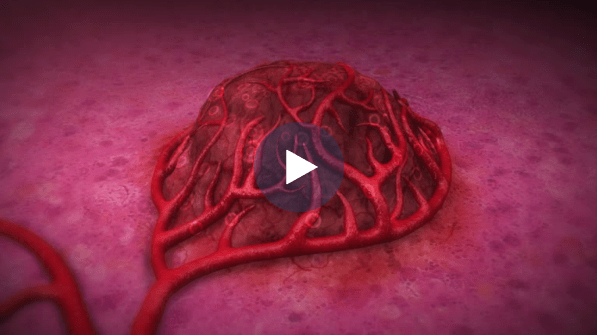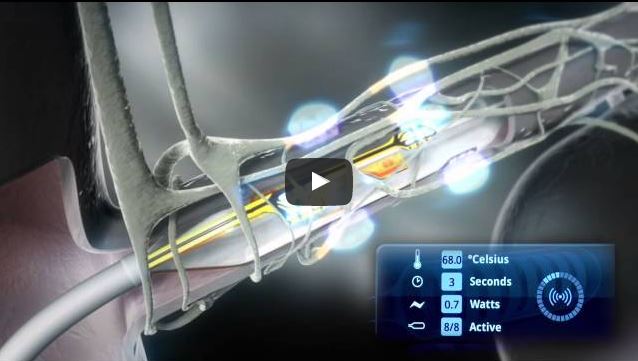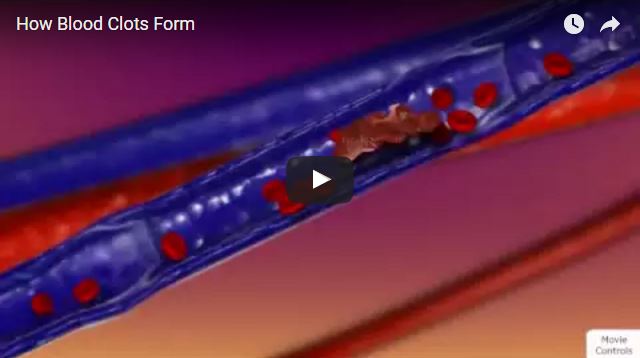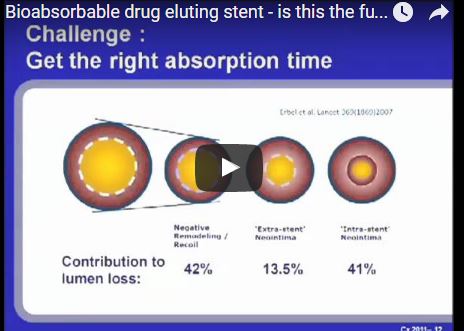At this year’s Charing Cross (CX) Symposium (23–25 April, London, UK), Manj Gohel (Cambridge University Hospitals, Cambridge, UK) spoke with Stephen Black (Guy’s and St Thomas’ Hospital, London, UK) about key takeaways from the venous programme.
Reflecting on the meeting,...
Naming microwave ablation as the "workhorse" of all ablation procedures performed by he and his team, Govindarajan Narayanan (Miami, USA) details his current practice and his early impressions using the IntelliBlate (Varian) solution.
For interventionists who have been performing microwave...
Dr. Ripal Gandhi and Dr. Nima Kokabi, with Alexander Villalobos acting as moderator, discuss their utilization and best practices with SIR-Spheres through 5 topics:
Dr. Ripal Gandhi and Dr. Nima Kokabi, with Alexander Villalobos acting as moderator, discuss their utilization...
Detailing the positive impact Allia IGS 7 has had on his daily practice, Vincent Vidal (Marseille, France) pinpoints usability, visualisation and radiation reduction as particular areas of marked improvement.
When performing cone beam computed tomography (CBCT) imaging prior to prostate...
In this short video, Michael Kostrzewa (Baden, Switzerland) and Rashid Akhtar (London, UK) discuss the latest approaches to the treatment of acute pulmonary embolism (PE) and deep vein thrombosis (DVT) using mechanical thrombectomy.
They examine which patients are eligible...
Vascular interventional radiologist Maria Antonella Ruffino (Interventional Radiology, IIMSI, Ente Ospedaliero Cantonale, Lugano, Switzerland) discusses her experience from the "men's world" of endovascular interventions, sharing insights from her innovative career with Interventional News.
Tracking her experiences from training to...
Matteo Tozzi (Varese, Italy) recently spoke to Vascular News about the role of drug-coated balloons (DCBs) in vascular access.
The full professor of vascular surgery at the University of Insubria started the use of Aperto® OTW DCB by Cardionovum® in his vascular...
NOTE: This video is ONLY available to watch in selected countries and geographies
Bulent Arslan (Chicago, USA) explores why interventional radiologists. interventional cardiologists and vascular surgeons should consider the Laguna Clot Retriever and Malibu Aspiration Catheter to experience its...
NOTE: This video is ONLY available to watch in selected countries and geographies
Yoshimitsu Soga (Fukuoka, Japan) spoke to Vascular News at the Leipzig Interventional Course (LINC) 2024 (28–31 May, Leipzig, Germany) about the SOL-Japan trial.
The interventional oncologist at...
Following her presentation on uterine artery embolization (UAE) for fibroids at the Global Embolisation Oncology Symposium Technologies (GEST; 16–19 May, New York, USA), Abeer AlDhawi (Riyadh, Saudi Arabia), describes the “significant relief” that can be provided to patients through...
Vicente Riambau (Barcelona, Spain) describes the unique features and improvements of the iCover balloon expandable covered stent, notably its low profile, radiopaque markers, and total encapsulation with polytetrafluoroethylene (ePTFE), which give the device an edge over its competitors and...
Experience wall-to-wall thrombectomy in action with Manuela Konert from Leipzig, Germany! In this brief video, Konert walks through a deep vein thrombosis (DVT) case step by step using the ClotTriever system, providing valuable clinical insights along the way. Highlighting...
NOTE: This video is ONLY available to watch in selected countries and geographies
Dominic Howard (Oxford University Hospitals NHS Trust, Oxford, UK) shares his thoughts on Penumbra’s computer-assisted vacuum thrombectomy offering. The technology, he comments, provides a “multi-level, all-in-one...
In a recent interview, Marie Josee van Rijn from Rotterdam, the Netherlands and Emma Wilton from Oxford, UK, provided insight into the transformative power of interventional approaches in the treatment of DVT. They also set the stage for the...
NOTE: This video is ONLY available to watch in selected countries and geographies
Consultant interventional radiologist, Andrew Wigham (Oxford, UK) examines his experience with the Lightning computer-assisted vacuum thrombectomy (CAVT; Penumbra), discussing how its technological advancements have broadened eligibility....
Clinical professor of radiology Mishal Mendiratta-Lala (Michigan, USA), expands on the first data release from the #HOPE4LIVER trial, presented during the FIRST@CIRSE session at this years Cardiovascular and Interventional Radiological Society of Europe (CIRSE) meeting.
“We are very excited about...
NOTE: This video is ONLY available to watch in selected countries and geographies
Thierry de Baère (Paris, France), Laurent Milot (Lyon, France) and Govindarajan Narayanan (Miami, USA) sit down for an Interventional News Expert Panel discussion on robotics in Interventional Oncology.
The...
NOTE: This video is ONLY available to watch in selected countries and geographies
The EffPac trial was a prospective, multicentre, randomised controlled trial (RCT) that enrolled 171 patients of Rutherford category two to four with medium-length femoropopliteal lesions. Patients...
“We wanted to find a common language between interventional radiologists and nephrologists and we wanted to be sure that the angioplasty we have done has a functional improvement”, associate professor of interventional radiology, Stavros Spiliopoulos (Athens, Greece) speaks to...
Yuji Okuno (Tokyo, Japan), winner of the Award of Excellence and Innovation in Interventional Radiology during the Cardiovascular and Interventional Radiological Society of Europe (CIRSE) 2023 meeting, discusses his pioneering work on the treatment of chronic musculoskeletal inflammation and...
Christoph Binkert (Winterthur, Switzerland) and current president of the Cardiovascular and Interventional Radiological Society of Europe (CIRSE) tells Interventional News about the three-fold focus and goals for interventional radiology (IR) in Europe, as defined by the society: clinical care;...
Raman Uberoi (Oxford, UK), who delivered this year’s Andreas Gruentzig Lecture at the CIRSE annual meeting told Interventional News: “We need to radically think about how we train future generations, how we support interventional radiologists to give them control over...
“The median thrombus age of DVT patients treated in our centre is 14 days – says Dr Andrew Wigham from Oxford University Hospitals. – We know that traditional treatment options such as thrombolytics and other thrombectomy devices are less...
Why is clot removal crucial for patients suffering from DVT? What are the major benefits of a lytic-free thrombectomy? Watch Michael Lichtenberg (Arnsberg, Germany) present the outcomes of the Arnsberg ClotTriever Study which confirms the safety and efficacy of...
NOTE: This video is ONLY available to watch in selected countries and geographies
The combined use of a drug-eluting device and a vascular scaffold “seems to be, in the longer run, the perfect solution for complex lesion treatment”. This...
Steven Abramowitz (Washington DC, USA) explains the significance of the CLOUT registry—the only registry capturing data on mechanical thrombectomy in deep venous thrombosis (DVT). CLOUT confirms excellent safety results and effectiveness of the ClotTriever system in real-world DVT patients....
A question from Manj Gohel (Cambridge University Hospitals NHS Foundation Trust, Cambridge, UK) on what the Charing Cross (CX) audience should take back to their multidisciplinary team meetings from the first-time presentation of BASIL-2 led chief investigator Andrew Bradbury...
A range of experts, including Koen Deloose (Dendermonde, Belgium), Thomas Zeller (Bad Krozingen, Germany), Marianne Brodmann (Graz, Austria) and Antonio Micari (Messina, Italy), talk to Vascular News about how the latest data supporting the cost-effectiveness of the IN.PACT Admiral drug-coated balloon...
Koen Deloose (Dendermonde, Belgium) talks to Vascular News about the key one-year data from the BIOPACT randomised controlled non-inferiority trial, which evaluated the safety and efficacy of the Passeo-18 Lux drug-coated balloon (DCB) catheter (Biotronik) compared to the IN.PACT Admiral...
Michel Reijnen (Arnhem, The Netherlands) presents the results of a study that sought to assess the potential cost-effectiveness of a urea-based drug-coated balloon (DCB; IN.PACT Admiral, Medtronic) as standard of care treatment for those with chronic limb threatening ischaemia...
David Gillespie (Boston, USA) talks to Interventional News about the PRESERVE study—established by the Society for Vascular Surgery and Society of Interventional Radiology—which is the largest prospective study to investigate real-world outcomes with contemporary use of inferior vena cava...
NOTE: This video is ONLY available to watch in selected countries and geographies
Robert Shahverdyan (Hamburg, Germany), Matteo Tozzi (Varese, Italy), Alexandros Mallios (Paris, France), Ounali Jaffer (London, UK) and Narayan Karunanithy (London, UK) each give their take on...
NOTE: This video is ONLY available to watch in selected countries and geographies
Iliac side branch devices (ISBs) are “gamechangers in infrarenal therapy of abdominal aortic aneurysms (AAAs),” Mario Lescan (Tübingen, Germany) tells Vascular News. Lescan states that ISBs “allow...
NOTE: This video is ONLY available to watch in selected countries and geographies
In this Vascular News roundtable, Andrew Holden (moderator; Auckland, New Zealand) is joined by Alexandros Mallios (Paris, France), Kate Steiner (Stevenage, UK) and Tobias Steinke (Düsseldorf, Germany) who...
Thierry De Baère (Gustave Roussy; Villejuif, France) talks to Interventional News about the rationale behind setting up the Initiative on Superselective Conventional Transarterial Chemoembolization (INSPIRE), which aims to bring Asian and European experts together in order to collaborate on standardising cTACE...
Speaking to Interventional News at the recent Cardiovascular and Interventional Radiological Society of Europe (CIRSE) 2022 annual meeting (10–14 September, Barcelona, Spain), Arthur Rocha (São Paulo, Brazil), from professor Carnevale’s team, shares the development of an optimised imaging workflow—which consists of...
Reto Bale (Innsbruck, Austria) talks to Interventional News at the Cardiovascular and Interventional Radiological Society of Europe (CIRSE) 2022 annual meeting (10–14 September, Barcelona, Spain) about some of the key benefits of using navigation and robotics during interventional radiology and oncology...
NOTE: This video is ONLY available to watch in selected countries and geographies
Lambros Tselikas (Villejuif, France) speaks to Interventional News about a recent retrospective study evaluating Liver ASSIST Virtual Parenchyma—the results of which he presented at the Cardiovascular and Interventional...
In this video, Vincent Vidal, Alexis Jacquier and Pierre-Antoine Barral share their testimonies about the Allia IGS 7.
This video is sponsored by GE Healthcare.
Gerd Grözinger (Tübingen, Germany) chats with Bernhard Gebauer (Berlin, Germany) at the Cardiovascular and Interventional Radiological Society of Europe (CIRSE) 2022 annual meeting (10–14 September, Barcelona, Spain) about some of the difficulties associated with treating patients with pulmonary embolism...
NOTE: This video is ONLY available to watch in selected countries and geographies
Thomas Zeller (Bad Krozingen, Germany) talks to Vascular News about the iliCo study, of which he is co-principal investigator, and which is designed to evaluate the...
Andrew Wigham (Oxford, UK) and Rick De Graaf (Friedrichshafen, Germany) discuss the current state of deep vein thrombosis (DVT) treatment at the Leipzig Interventional Course (LINC) 2022 (6–9 June, Leipzig, Germany), with both noting that “a massive problem” in...
Robert Jones (Birmingham, UK), Interventional radiologist and president of the Vascular Access Society of Britain and Ireland (VASBI), tells Renal Interventions at the Endovascular Access meeting (EVA; 24–25 June, Patras, Greece) that there are still significant untapped areas for...
NOTE: This video is ONLY available to watch in selected countries and geographies
In a late-breaking Podium 1st presentation at the 2022 Charing Cross (CX) International Symposium (26–28 April, London, UK), Andrew Holden (Auckland, New Zealand) revealed that patients...
NOTE: This video is ONLY available to watch in selected countries and geographies
The “ideal patient” for a balloon-occluded transcatheter arterial chemoembolization (B-TACE) procedure should have lesions between 3–5cm, peripherally located, in which appropriate positioning of the microballoon can...
NOTE: This video is ONLY available to watch in selected countries and geographies
Marianne Brodmann (Medical University of Graz, Division of Angiology, Austria) talks about the clinical results of the EMINENT randomised controlled trial, arguing that drug-eluting stents (DES)...
NOTE: This video is ONLY available to watch in selected countries and geographies
Thierry De Baere (Villejuif, France) talks to Interventional News about the current clinical evidence supporting the use of balloon-occluded transcatheter arterial chemoembolization (B-TACE) with the Occlusafe™...
NOTE: This video is ONLY available to watch in selected countries and geographies
Gunnar Tepe (interventional radiologist, Germany) discusses the results and subsequent impact of the EMINENT randomised controlled trial on his practice, explaining that the Eluvia stent has...
NOTE: This video is ONLY available to watch in selected countries and geographies
Koen Deloose (vascular surgeon, Belgium) looks at the evidence needed in order to make the best decision for his patients when treating the superficial femoral artery (SFA)....
NOTE: This video is ONLY available to watch in selected countries and geographies
Antonio Micari (interventional cardiologist, Italy) gives his thoughts on the EMINENT RCT and whether it may have influenced his decision to use drug-eluting stents and drug...
NOTE: This video is ONLY available to watch in selected countries and geographies
Yann Goueffic (vascular surgeon, France) discusses the evidence that is needed for the best treatment strategy of the femoropopliteal segment. He examines a range of stents,...
Peter Littler (Newcastle, UK) talks to Gerard McLauchlan (Surrey, UK) and Alex Horton (Surrey, UK) about veterinary interventional radiology following a special session titled All Creatures Great and Small: IR for animals at the British Society of Interventional Radiology...
“Young interventional radiologists have got a very exciting future,” Trevor Cleveland (Sheffield, UK, and a former president of the British Society of Interventional Radiology ), tells Interventional News. In 2021, Cleveland delivered the Wattie Fletcher lecture at the BSIR Annual Scientific Meeting (8–10 December, Glasgow, UK).
In discussing the...
Nicholas Inston (consultant vascular access and renal transplant surgeon, Birmingham, UK) discusses the crucial care interventional radiologists provide for renal patients with Ian Mcafferty (consultant interventional radiologist, Birmingham, UK, and immediate past president of the British Society of Interventional...
Jon Bell (Manchester, UK) outlines the importance of standardisation of selective internal radiation therapy (SIRT) and how this rests on an advanced understanding of personalised dosimetry to achieve optimal outcomes for hepatocellular carcinoma (HCC) patients. “So interventional radiologists, wherever they work, will...
Elika Kashef (London, UK) addresses the implications of interventional radiology not being equally accessible to people from all walks of life. This has triggered a re-think in the aspirations and nomenclature of the British Society of Interventional Radiology (BSIR)...
Alexandros Mallios (Paris, France) and Robert Shahverdyan (Hamburg, Germany) talk to Vascular News about some of the benefits of the Ellipsys™ Vascular Access System (Medtronic), how it compares to more traditional fistula creation techniques, and the key steps for...
Many patients are outliving their gastrointestinal (GI) stents, and this can pose particular problems. “In the last few years, we have seen quite a dramatic increase in patients who present with a structural failure of their stent in the upper GI tract, notably the oesophagus, stomach and duodenum,...
The British Society for Interventional Radiology (BSIR) has set up an interventional radiology (IR) registry to capture a glimpse of the scope, breadth and immediate complication rate provided by the service in the UK. In parallel, UK interventional radiologists...
After COP26, it is time for the interventional radiology world to congregate in Glasgow, UK. Diversity, veterinary interventions, sun tan, or single malt–everyone has their own reasons to head there.
Hear from Alex Barnacle (London; British Society for Interventional Radiology...
The upcoming Controversies in Dialysis Access (CiDA) meeting in Dallas, Texas is stepping up the scrutiny on the controversies and questions currently igniting the dialysis community, Bart Dolmatch (Portola Valley, USA) tells Renal Interventions at the Paris Vascular Insights...
In this penultimate episode of a special five-part series on the history of drug-coated balloons (DCBs), Jos van den Berg (Lugano, Switzerland) is joined by Gunnar Tepe (Rosenheim, Germany) and Thomas Zeller (Bad Krozingen, Germany), with the trio discussing...
After a successful introduction of Azurion with SmartCT in 2020, many users have experienced working with the new solution from Philips. Watch the video to learn from our early users how 3D imaging capabilities on their image-guided therapy system...
NOTE: This video is ONLY available to watch in selected countries and geographies
Bruno Migliara (Peschiera del Garda, Italy) talks to Vascular News about the reasons why bypass failure, which he notes is “really dangerous for life and limb”, is so...
“Like anything in the medical community, there can be positive and negative,” Agnieszka Solberg (Bismarck, USA) tells Interventional News discussing the impact of social media in the fields of interventional and neuroradiology.
As a founder of the RadChicks movement—an online...
The CAVA (Central venous access devices for the delivery of systemic anticancer therapy) randomised controlled trial (RCT), just published in The Lancet, has revealed that totally implanted ports (PORTs) are more effective and safer than both Hickman-type tunnelled catheters...
In this third episode of a special five-part series on the history of DCBs, Jos van den Berg (Lugano, Switzerland) moderates a Interventional News roundtable discussion where he is joined by John Laird (St Helena, USA) and Peter Schneider (San...
Constantinos Sofocleous (New York, USA) sits down with Interventional News to discuss how image-guided thermal ablation, when it is deployed with an intent to cure small colorectal liver metastases, can be fine-tuned so that its outcomes match those achieved...
NOTE: This video is ONLY available to watch in selected countries and geographies
In case of embolisation, Interlock and IDC Detachable Coils (Boston Scientific) associate precision and control of a detachable coil to the powerful thrombogenicity of a fibered...
Andrew Holden (Auckland, New Zealand) presents the latest results from the IN.PACT™ AV Access trial (Medtronic), which indicate “outstanding” target-lesion primary patency rates of 52.2% through 24 months in dialysis patients with dysfunctional arteriovenous fistulas (AVFs), offering a “highly-significant advantage” over standard...
Histotripsy, which was invented at the University of Michigan, uses pulsed sound waves to destroy tissue. It is a non-invasive and non-thermal mechanism that is currently being studied for its “completely different mechanism for ablating tissue, which we...
“Not all Drug-Coated Balloons (DCBs) are created equal”, Juan Granada (New York, USA), tells Vascular News in this second episode of a four-part series on the history of DCBs.
Granada discusses why there are differences in these devices, noting that some have a longer term retention of drug,...
NOTE: This video is ONLY available to watch in selected countries and geographies
Koen Deloose (Dendermonde, Belgium) moderates a three-part Vascular News series about the Luminor drug-coated balloon (DCB; iVascular) in different indications. He is joined by Tjun Tang (Singapore) and...
NOTE: This video is ONLY available to watch in selected countries and geographies
Koen Deloose (Dendermonde, Belgium) moderates a three-part Vascular News series about the Luminor drug-coated balloon (DCB; iVascular) in different indications. He is joined by Tjun Tang (Singapore) and...
NOTE: This video is ONLY available to watch in selected countries and geographies
Koen Deloose (Dendermonde, Belgium) moderates a three-part Vascular News series about the Luminor drug-coated balloon (DCB; iVascular) in different indications. He is joined by Tjun Tang (Singapore) and...
Constantino Peña (Miami, USA) moderates an Interventional News webinar focusing on how the SmartCT system (Philips) can “transform” IR suites and the importance of 3D imaging within this setting. Peña is joined by two early-users of the technology, Marc...
NOTE: This video is ONLY available to watch in selected countries and geographies
Sabine Steiner (Leipzig, Germany) sits down with Michael Jaff, the CMO & VP of Boston Scientific, USA, to discuss the two-year results from the COMPARE trial,...
NOTE: This video is ONLY available to watch in selected countries and geographies
Jason Levy (Atlanta, USA) and Elizabeth David (Toronto, Canada) talk to Interventional News about the final cohort data from the OPuS One clinical study, the results of...
Atul Gupta (Philadelphia, USA), chief medical officer of Image Guided Therapy at Philips, comments on the SmartCT clinical application software–part of the Azurion image guided therapy platform–which, he notes, makes 3D and CT imaging “really simple”.
Gupta outlines which clinical...
There are some amazing things planned for GEST 2021. Hear from the course directors on why you should attend on April 30–May 2 and the focus days throughout the year. Although the event is virtual, attendees should expect the...
Daniel Sze (Palo Alto, USA) recently took the reins of the Journal of Vascular and Interventional Radiology (JVIR) as editor-in-chief.
He plans to extend specific efforts to encourage increased contributions from underrepresented groups such as women, under-represented minorities (URMs), and...
Interventional radiologists were often at the frontlines, doing remarkably large numbers of procedures treating COVID-19 patients and among the only specialties that carried on staffing hospitals, providing daily services such as putting in dialysis catheters or treating COVID-19 related...
The adrenaline-rush of seeing or doing an elegant procedure that can alter the course of a patient’s life is often the career-inspiring doorway into interventional radiology. But, over time, there needs to be a pivot to a different approach...
President of the American College of Radiology (ACR), Geraldine McGinty is also a radiologist and the chief strategy officer, as well as the chief contracting officer, at Weill Cornell Medicine (New York City, USA). She presented the InspIRed Lecture...
To mark the 20-year anniversary of drug-coated balloons, Bruno Scheller (Homburg/Saar, Germany) and Gunnar Tepe (Rosenheim, Germany), talk to Vascular News about their contributions to the birth and evolution of these devices.
Scheller discusses his work in the 1990s with...
NOTE: This video is ONLY available to watch in selected countries and geographies
Tobias Steinke (Düsseldorf, Germany), Matteo Tozzi (Varese, Italy) and Robert Shahverdyan (Hamburg, Germany) give their reactions to the publication in the New England Journal of Medicine...
NOTE: This video is ONLY available to watch in selected countries and geographies
Ralf Langhoff (Berlin, Germany) talks to Vascular News about the 12-month data from the CONSEQUENT study, which aims to assess the safety and efficacy of the SeQuent®...
Bart Dolmatch (Portola Valley, USA) talks to Vascular News about some of the key data highlights from the 24-month AVeNEW trial, which compared the safety and efficacy of the Covera™ Vascular covered stent (BD) against percutaneous transluminal angioplasty (PTA) for the treatment...
A trio of vascular experts including Raphaël Coscas (Paris, France), Alexandros Mallios (Paris, France) and Kate Steiner (Stevenage, UK) discuss the key findings of the IN.PACT™ AV Access trial–which was recently published in the New England Journal of Medicine...
“Not everything that is published is true or important” and “always be critical, but not cynical,” urges Jim Reekers, editor-in-chief of CVIR Endovascular, as he talks about filters that operate in the world of scientific and medical publishing that...
Felipe Nasser (São Paulo, Brazil) talks to Interventional News about his experience of the COVID-19 pandemic after contracting the SARS-CoV-2 virus himself, saying that the infection and period of isolation “made me think a lot about my life.” “We are now prepared” and “know how to face a situation...
Pua Uei (Singapore) talks to Interventional News about how Singapore’s interventional radiologists (IRs) in Tan Tock Seng Hospital and National Centre for Infectious Disease (NCID) dealt with the ongoing COVID-19 crisis. Singapore was one of the first countries to register a case outside of...
On the opening day of BSIR 2020 (1–3 December, virtual), Lakshmi Ratnam (London, UK), chair of the scientific programme committee, moderates a special Interventional News panel with BSIR president, Ian McCafferty (Birmingham, UK), and vice-president, Philip Haslam (Newcastle, UK).
McCafferty...
NOTE: This video is ONLY available to watch in selected countries and geographies
Robert Lookstein (New York, USA; principal investigator) and Andrew Holden (Auckland, New Zealand; principal investigator) discuss the key six-month results and implications from the IN.PACT™ AV...
Sean Lyden (Cleveland, USA), current VIVA Board president, speaks to Vascular News about his two years at the helm, which began with the “controversy on paclitaxel” and has led right up to COVID-19 and the first virtual VIVA meeting. Ten...
Moderate-to-severe calcification in peripheral arteries is an “ongoing battle” in in the endovascular treatment of complex lesions, William Gray (Philadelphia, USA), tells Vascular News.
Gray explains that there are a number of tools deployed to win the acute battle, but notes frankly that they...
Efthymios Avgerinos (Pittsburgh, USA) speaks to Interventional News about the SUNSET sPE trial, the one-year results of which he presented at VIVA 2020 (Vascular International Advances; 6–8 November, virtual), and which compared ultrasound-assisted thrombolysis (USAT) to standard catheter-directed thrombolysis...
Raul Uppot (Massachusetts General Hospital, Boston, USA) speaks to Interventional News about the evolution of hepatic ablation, following his talk on the same topic at the recent Symposium on Clinical Interventional Oncology (CIO).
He says: "What I want people to know...
NOTE: This video is ONLY available to watch in selected countries and geographies
Ripal Gandhi (Miami, USA) outlines his initial experiences with the Caterpillar™ Arterial Embolization Device (BD), a product, which he says is easy to utilize, shows good trackability in tortuous vessels and allows for “very accurate placement”.
Gandhi describes the novel device, which consists...
Radiofrequency ablation (RFA) is a successful treatment option for patients with painful osteolytic bone metastases, Jason Levy (Northside, Forsyth, and Cherokee Hospitals, Atlanta, USA) and Sandeep Bagla (Vascular Interventional Partners of northern Virginia, Springfield, USA) conclude, discussing the results...
Throwback to the 2019 Society of Interventional Radiology annual scientific meeting when Interventional News interviewed Bart Dolmatch (Mountain View, USA) on the early results of the AVeNEW trial - the first Level One trial dedicated solely to assess the safety and efficacy of the Covera (BD) covered stent designed to treat stenosis in the arteriovenous (AV) fistula access circuit.
The early results were...
Data from an unselected, real-world cohort of 64,000 claimants of the German BARMER Health Insurance reveals no signal of increased long-term mortality when paclitaxel-based devices are used in the femoropopliteal arteries, Eva Freisinger (Münster, Germany) told BLearning Peripheral at...
The Charing Cross (CX) Symposium, with its world-class faculty and unique focus on live audience participation, has announced the launch of a not-to-be missed and timely vascular and endovascular education virtual event: CX 2020 LIVE. Mark your calendars for this...
Larry Scher (New York, USA) interviews John Aruny (Orangeburg, USA) and Stephen Hohmann (Dallas, USA) for VEITHtv at the VEITHsymposium (19–23 November, New York, USA) about the role of percutaneous AV fistulas in contemporary haemodialysis practice.
Aruny says physicians are “on the brink of a whole new...
Edward Choke (Singapore) talks to BLearning Peripheral at LINC 2020 (Leipzig Interventional Course; 28–31 January 2020, Leipzig, Germany) about the first-in-man clinical study—XTOSI—which looked at the safety and efficacy of a sirolimus drug-coated balloon (DCB) in the treatment of peripheral arterial disease. interim
The...
NOTE: This video is ONLY available to watch in selected countries and geographies
Geert Maleux (Leuven, Belgium), one of the first users of the SeQure® reflux control microcatheter (Guerbet) in Europe, shares his experience with the new device. He tells BLearning...
NOTE: This video is ONLY available to watch in selected countries and geographies
Andrew Holden (Auckland, New Zealand), Alexandros Mallios (Paris, France), Robert Lookstein (New York, USA) and Tobias Steinke (Dusseldorf, Germany) talk to BLearning Peripheral about the 12-month results...
Andrea Kahlberg (Milan, Italy) talks to BLearning Peripheral at LINC 2020 (Leipzig Interventional Course; 28–31 January 2020, Leipzig, Germany) about a novel sirolimus-eluting self-expanding nitinol stent that Kahlberg claims “has the ability to improve the long-term results” of superficial femoral artery (SFA) endovascular...
Peter Schneider (San Francisco, USA) talks to BLearning Peripheral at LINC 2020 (Leipzig Interventional Course; 28–31 January 2020, Leipzig, Germany) about the relevance of dose relationship and geographical data when discussing the controversy surrounding the use of paclitaxel devices in peripheral arterial disease...
Sean Lyden (Cleveland, USA) talks to VEITHtv at the VEITHsymposium 2019 (19–23 November, New York, USA) about the “tumultuous” year for the industry following the publication of the 2018 Katsanos meta-analysis which showed an increased mortality risk with the use of paclitaxel-coated balloons at five-years in...
Dierk Scheinert (Leipzig, Germany) moderates a panel with Eva Freisinger (Münster, Germany) and Thomas Zeller (Bad Krozingen, Germany) to discuss the developments over the past 12 months surrounding the safety of paclitaxel.
Zeller notes that further analyses of the randomised...
The first head-to-head randomised controlled trial to directly compare two different drug-coated balloons—the lower-dose density (2μg/mm2) Ranger and higher-dose density (3.5μg/mm2) IN.PACT—showed similar results with regard to effectiveness and safety through 12 months for femoropopliteal interventions, Dierk Scheinert (Leipzig, Germany)...
Kenneth Ouriel (New York, USA) talks to BLearning Peripheral at LINC 2020 (Leipzig Interventional Course; 28–31 January 2020, Leipzig, Germany) about a recent independent analysis to assess safety outcomes of femoropopliteal drug-coated balloon (DCB) angioplasty using patient-level data from the Lutonix clinical programme—and...
Frank Arko (Charlotte, USA) talks to VEITHtv at the VEITHsymposium 2019 (19–23 November, New York, USA), about the benefits of using Shockwave Intravascular Lithotripsy (IVL) when performing EVAR and TEVAR through calcified iliac arteries.
Arko, who shares some of the downsides of traditional procedures...
NOTE: This video is ONLY available to watch in selected countries and geographies
The one-year IN.PACT AV trial results, first presented at LINC 2020 (28–31 January, Leipzig, Germany), reveal that the target lesion primary patency in the patient group treated with the...
Juan Granada (New York, USA) chats to Sahil Parikh (New York, USA) for VEITHtv about below-the-knee (BTK) intervention and innovation and how the paclitaxel controversy has influenced the treatment of BTK disease.
Parikh says: “Frankly there is a lot of dampened enthusiasm”...
George Adams (Raleigh, USA) talks to VEITHtv at the VEITHsymposium 2019 (19–23 November, New York, USA) about the benefits of using easy-to-use Shockwave IVL (Intravascular Lithotripsy) in calcified below-the-knee vessels, which he says, results in “great outcomes”.
Adams explains that calcific plaque, particularly medial...
Vascular and interventional cardiology experts including Kim Hodgson (Springfield, USA), Ramon Varcoe (Sydney, Australia) and Gary Ansel (Columbus, USA) give their thoughts on the recently released meta-analysis in JVIR, which has suggested an increased risk of death or amputation...
A range of interventional radiologists experts including Michael Dake (Tucson, USA), John Kaufman (Portland, USA), Jim Reekers (Amsterdam, The Netherlands) and Gunnar Tepe (Rosenheim, Germany) give their thoughts on the recently released meta-analysis in JVIR, which has suggested an...
Akhilesh Sista (New York, USA) talks to Interventional News at VIVA 2019 (Vascular InterVentional Advances; 4–7 November, Las Vegas, USA) about the results of the EXTRACT-PE study, that were presented in a late-breaking clinical trial session at the meeting.
EXTRACT-PE successfully met the primary endpoints, demonstrating the safety and efficacy...
Konstantinos Donas (Münster, Germany) reported five-year data from a single-centre, retrospective study with 238 patients in the first CIRSE session. The long-term, real-world dataset showed no increased mortality for the matched patients who underwent paclitaxel-coated balloon treatment vs. those treated with...
Nick Hopkins (Buffalo, USA) talks to BLearning Neuro at VEITH Symposium 2018 (13–17 November 2018, New York, USA) about the DAWN trial, which showed that in carefully selected acute ischaemic stroke patients that “intervention out to 24 hours is viable”.
“Stroke intervention is the next...
Gerard Goh (Melbourne, Australia) talks to BLearning IR at CIRSE 2019 (Cardiovascular and Interventional Radiological Society of Europe; 7–11 September; Barcelona, Spain) about Australian public Medicare data which has shown a “huge disparity” between the number of hysterectomies performed each year compared with...
Jos van den Berg (Lugano, Switzerland) tells Interventional News at CIRSE 2019 that the results of the APERTO AVF China trial provide strong evidence of the benefits of using the APERTO drug-coated balloon (DCB; Cardionovum) in haemodialysis patients who had stenosis of, mainly, de novo...
Andrew Holden (Auckland, New Zealand) provides perspective on the first results from the Disrupt PAD III observational registry that were presented at the Charing Cross International Symposium 2019. This large registry is designed to evaluate the use of Intravascular...
Lorenzo Patrone (London, UK) shares with Blearning at CIRSE 2019 (7–11 September, Barcelona, Spain) the benefits of using the OUTBACK™ Elite Re-entry Catheter (Cordis, a Cardinal Health Company) in chronic total occlusions—in any arterial segment from the iliacs to...
The prospective, randomised SINGA-PACLI trial sought to compare the results of drug-coated balloon (DCB) treatment to plain balloon angioplasty (POBA) for the treatment of infragenicular lesions in patients with critical limb ischaemia.
Tan Bien Soo (Singapore), principal investigator of the...
NOTE: ONLY intended for healthcare professionals outside of the USA and France.
Zoom in on a tête-à-tete between Marianne Brodmann (Graz, Austria) and Giovanni Torsello (Munster, Germany) who talk through the latest clinical evidence that directly compares drug-eluting stents in...
NOTE: ONLY intended for healthcare professionals outside of the USA.
Ulf Teichgräber (Jena, Germany) and Koen Deloose (Dendermonde, Belgium) discuss the 24-month results of the EFFPAC trial and the six-month outcomes of the TINTIN trial. Both trials used the luminor...
CIRSE 2019 Gold Medal awardee, Thierry de Baère (Villejuif, France), tells Interventional News at the society’s annual meeting (7-11 September, Barcelona, Spain) that this award is a reflection of CIRSE’s interest and engagement with interventional oncology (IO).
On the IO...
NOTE: This video is ONLY available to watch in selected countries and geographies
Jos van den Berg (Lugano, Switzerland) speaks to Andrew Holden (Auckland, New Zealand) to distil the headline findings from the first-ever results of the IN.PACT AV access...
Michael Dake (Tucson, Arizona) presented the two-year data from the VERNACULAR trial at CIRSE 2019 on 8 September in Barcelona, Spain.
Dake said: “The 24-month results from the VERNACULAR trial using the BD Venovo stent show absolutely sustained benefit in...
Ashutosh Rao (Atlanta, USA) talks to Interventional News at SIR 2019 about the OnControl device. Before switching to OnControl, Rao explains, “we did not realise how easy bone biopsies could be”.
Rao notes that sometimes bone lesions are not on the proximal side...
Irene Bargellini (Pisa, Italy) tells BLearning IR at the first Embolotherapy conference (ET; 26–29 June, Valencia, Spain) that non-target embolization is a frequently under-diagnosed, sometimes fatal, problem that interventional radiologists encounter every time they work with embolics.
Understanding the vascular...
Sanjay Misra (Rochester, USA) talks to Interventional News about his research into whether stem cell therapy can help AVFs (arteriovenous fistulas) mature and also prevent venous stenosis. The pilot study with a small group of haemodialysis AVF patients led to “promising...
Jos van den Berg (Lugano, Switzerland), Antonio Micari (Bergamo, Italy) and Marianne Brodmann (Graz, Austria) sit down after a specially convened US FDA panel reviewed paclitaxel device data, with recommendations still to come. The physicians discuss the safety of...
Speaking at the Charing Cross Symposium 2019 (CX; 15–18 April, London, UK), Jeffrey Jump (Nyon, Switzerland) outlines the impact of the Medical Device Regulations (MDR), which he believes will be “the most devastating thing to happen to European healthcare...
Transarterial chemoembolization using microspheres appears to show “much better outcomes” than those seen with conventional TACE, both in the setting of hepatocellular carcinoma (HCC) treatment and when used to treat colorectal cancer patients, Philippe Pereira (Heilbronn, Germany) tells Interventional...
Rajesh Dave (Camp Hill, USA) talks to iWounds News about his highlights from the 15th annual C3 conference, which included a special session on the paclitaxel controversy.
Dave talks about the “journey of 15 years” and how the meeting started...
While the standard approach for preparing the future liver remnant prior to liver resection is to use portal vein embolization, a new technique—variously either called double vein embolization, or liver venous deprivation—can enhance the rapidity of the desired response....
Dan Sze (Palo Alto, USA), chair, 2019 Annual Meeting Program and Nadine Abi-Jaoudeh (Orange, USA), chair, 2019 Scientific Program, discuss the highlights of the 2019 Society of Interventional Radiology (SIR) Annual Scientific Meeting. The programme-makers set out to turn some...
There is a huge group of knee osteoarthritis patients in whom conservative therapy fails. Yet, many of these patients are not candidates for joint replacement. If proven to have long-term benefits, geniculate artery embolization—a minimally invasive procedure performed in...
Jason Levy (Atlanta, USA) and Sandeep Bagla (Virginia, USA) talk to Interventional News about preliminary results from the ongoing OPuS One study. The OPuS One post market study is currently collecting real world data on the effectiveness of the...
Watch the video roundup from the CX2019 Highlight Session, Paclitaxel: The last word.
Filmed onsite at the Charing Cross Symposium (15–18 April 2019, London, UK).
Eluvia DES is the only technology that uses polymer-based drug delivery to treat Peripheral Artery Disease (PAD). Its polymer ensures that the majority of drug is delivered to the tissue while minimizing downstream particulates. Boston Scientific has more than...
Riad Salem (Chicago, USA) tells Interventional News at the SIR annual scientific meeting that removing a key step—the MAA scan to determine lung shunting—in a select subset of patients undergoing multistep Y-90 procedure can bring down the skin-to-treatment time...
Jonathan Beard (Sheffield, UK) discusses the current medico-legal issues in the field and explains how interventionalists can become “the fall-guy for the inadequacies of other clinicians”. Beard touches on how the threshold for informed consent has changed “dramatically” in...
The use of mixed reality will enable interventionists to see 3D anatomy ‘in 3D’, as a hologram (as opposed to on a 2D screen). “Having holography that I can reach out, grab and move around like a virtual object is going to...
Kevin Seals (San Francisco, USA) and Andrew Taylor (San Francisco, USA) talk to Interventional News at SIR 2019 about the current and future use of smart speaker technology in the angiosuite, which allows interventional radiologists to access critical digital...
Following the latest information presented at the Charing Cross (CX) International Symposium related to the meta-analysis of paclitaxel-coated devices (Katsanos et al), hear from a multi-specialty panel of global experts who are discussing their current practice and the way they...
At the Charing Cross International Symposium, Gary Ansel (Columbus, Ohio) moderates a global panel that includes Thomas Albrecht (Berlin, Germany), Peter Schneider (San Francisco, USA) and Eric Secemsky (Boston, USA). The panel outlines the value of paclitaxel devices in...
There were calls for greater transparency and sharing of the available randomised controlled trial data of paclitaxel-coated devices at the CX 2019 Highlight Session, Paclitaxel: The Last Word. The session also emphasised the need for a meta-analysis of individual patient-level data...
Martin Radvany (Little Rock, USA) and Joan Wojak (Lafayette, USA) tell Interventional News that there is a shortage of physicians that are trained to perform stroke thrombectomy and to look after patients after the procedure. It is vital for...
Laura Findeiss, (Atlanta, USA) president of SIR, talks to Interventional News about the society's efforts to improve access to interventional radiology (IR) in communities across the globe. Findeiss touches on the issues that hinder the widespread adoption of IR,...
Alan Matsumoto (Charlottesville, USA) talks to Interventional News about the disruption and fragmentation that is causing a “tornado in healthcare”. He expanded on how interventional radiologists should show “unity in purpose” in the face of disaggregating forces such as...
Paclitaxel kills the cells in the artery wall; sirolimus simply stuns them. So says Peter Gaines (Sheffield, UK) at VLF 2019 while commenting on the modes of action of these two agents that have been used in drug-coated devices...
Eric Secemsky (Boston, USA) takes Interventional News through the main highlights of his recently published analyses of a US Medicare claims dataset that examined the association between drug-eluting devices and mortality in peripheral arterial disease patients. Secemsky spoke at...
The renal denervation bubble collapsed due to a single trial—SYMPLICITY HTN-3, but this trial’s findings went against the grain, Horst Sievert (Frankfurt, Germany) tells Interventional News at CRT 2019. Sievert shares early results of alcohol-mediated renal denervation, which were presented as a late-breaking abstract...
Bringing interventional oncology (IO) and radiation oncology (RO) closer together would yield more than important logistical gains for IO; it would open up a wealth of possibilities for patients. Andy Adam (London, UK; an interventional radiologist) and Lizbeth Kenny...
Gary Ansel (Columbus, USA) tells Vascular News at VEITHSymposium 2018 about how drug-based therapies have become a mainstay in femoropopliteal revascularisation and how interventionalists should be using best medical therapy “more than we do ”. He also shares his...
In the arterial space, VIVA 2018 focused on the fact that there is an increasing awareness of limb threatening ischaemia coupled with an increase in interventional tools, but no clear defined pathway for treatment. There is also uncertainty about...
Jihad Mustapha (Grand Rapids, USA) explains how the Temporary Spur stent system (Reflow), which is a spiked self-expanding stent is intended for use in conjunction with a drug-coated balloon, works to help deliver drug to the media or subintima...
Nicholas Inston (Birmingham, UK) tells Vascular News at LINC 2019 about the exciting field of percutaneous arteriovenous fistula (AVF) creation, the main devices and trials in the space and the lack of long-term evidence showing AVFs created percutaneously “are still...
At the EKOS symposium at LINC 2019, Nils Kucher (Zurich, Switzerland), Houman Jalaie (Aachen, Germany) and Mert Dumantepe (Istanbul, Turkey) share their experiences in treatment of pulmonary embolism, acute and chronic deep venous thrombosis (DVT) using acoustic pulse thrombolysis.
This...
Dierk Scheinert (Leipzig, Germany) talks to Vascular News at LINC 2019 about the importance of vessel preparation with adjunctive therapies such as the use of the dedicated scoring balloon, ULTRASCORE (BD), prior to the use of a drug-coated balloon...
Sean Lyden (Cleveland, USA) and Fabrizio Fanelli (Rome, Italy) discuss the safety and future of drug-coated balloons (DCB) in light of the latest pooled analysis of patient-level data of over 2,300 patients treated with Philips’ Stellarex DCB in above-the-knee...
Renowned experts expressed confidence in the continued use of paclitaxel-coated devices after independent patient-level data presented at LINC 2019 did not show correlation between paclitaxel exposure and mortality.
Findings from Baim (formerly Harvard Clinical Research Institute) are now published in...
A renowned panel, moderated by Dierk Scheinert (Leipzig, Germany), comprising Peter Schneider (Honolulu, USA), John Laird (St Helena, USA) and Thomas Zeller (Bad Krozingen, Germany) expressed confidence in the continued use of paclitaxel-coated devices after individual patient-level data were...
An analysis ATTRACT has just been published in the journal, Circulation in which the authors examine the effect of pharmacomechanical catheter-directed therapy (PCDT) in ATTRACT patients with iliofemoral DVT.
Interventional News spoke to Mark Garcia (Wilmington, USA), Jacob Cynamon (New York,...
Konstantinos Katsanos (Patras, Greece) tells Interventional News about new data from a meta-analysis that has been published in the Journal of the American Heart Association (JAHA) that suggest there is an increased risk of death at two and five...
“There are simply not enough trained specialists to treat stroke patients in the US. We need to recruit physicians with endovascular skills—interventional cardiologists, interventional radiologists and vascular surgeons—to train them appropriately so that they can help deliver endovascular...
Michael Jaff (Newton, USA) outlines the major recent developments in best medical therapy that will impact the treatment of peripheral arterial disease (PAD) at VEITHsymposium 2018.
Raman Uberoi (Oxford, UK) tells Interventional News at CIRSE 2018 in Lisbon, Portugal, that offering any treatment for abdominal aortic aneurysms, be it endovascular aortic repair (EVAR), open surgery, or best medical therapy, should depend on putting the patient...
Treating severely calcified arteries by endovascular means is still a challenge, although atherectomy, stents and lithotripsy are all techniques that are employed. Lithotripsy (also called Lithoplasty) seeks to microfragment the calcium seen in the vessels of peripheral arterial disease...
Individual evaluation of each patient, and each aorta, is key to durable repair
“The instructions for use (IFU) are not a clinical guideline, so trainees should really think about what the main considerations are when they are implanting devices in...
Daniel Sze (Stanford, USA) tells Interventional News that the focus on diversity is not just about social justice. “It is really about bringing the many good ideas and innovations that will come from women and underrepresented minorities to the table in...
Tobias Steinke (Dusseldorf, Germany) reported on the Lutonix Global arteriovenous (AV) Registry at CIRSE 2018 in Lisbon, Portugal. Lutonix Global AV Registry data add to real-world outcomes of using Lutonix DCB in AV access.
Straight after the presentation, Steinke tells Interventional News about...
Darren Klass (Vancouver, Canada) tells Interventional News that social media is helping spread the word about the back hand approach for distal radial access. Klass also elaborates on the technique’s advantages and his team’s experience with it.
Sneak preview: Anna Maria Belli (London, UK; right in video), who was awarded the CIRSE Gold Medal at the 2018 meeting in Lisbon, Portugal, and Tze Min Wah (Leeds, UK) tell Interventional News that addressing the concerns about radiation...
Christoph Binkert (Kantonsspital, Winterthur, Switzerland) tells Interventional News at CIRSE 2018 in Lisbon, Portugal, that the transradial approach is rapidly gaining momentum in Europe for use in visceral embolization, but that it needs longer lengths of tools before it...
Andrew Holden (Auckland, News Zealand) interviews Stefan Mueller-Huelsbeck (Flensburg, Germany) to distil the key findings of the IMPERIAL trial one-year data that were presented for the very first time at CIRSE 2018 in Lisbon.
In the randomised controlled trial, Eluvia,...
M Victoria Marx, an interventional radiologist at Keck Medicine of USC, Los Angeles, USA, has been appointed president of the Society of Interventional Radiology (SIR) for 2018–2019.
Marx tells Interventional News: “My main goal is to continue the momentum that we...
This content is for distribution within USA only.
The Direxion™ Microcatheter, with its unique shaft design, offers you unrivaled torqueability for improved maneuverability. Further enhancing your ability to access challenging treatment sites are a variety of tip shapes that allow...
This content is for distribution within USA only.
As you pursue new and innovative procedures within more complex anatomy, you need precision and control like never before. Fathom Steerable Guidewires feature a nitinol hypotube distal segment—a design that revolutionizes the...
https://www.youtube.com/watch?v=QH9H-hwdb6o&feature=youtu.be
Francesco Carnevale (São Paulo, Brazil) speaks on the growing acceptance for prostatic artery embolization. The national regulatory bodies in Brazil and the UK recommending the procedure are "a huge development in the field of embolization", he tells Interventional News...
Ulf Teichgräber, Jena, Germany, discusses the EffPAC trial 12-month results which were presented for the first time at CX 2018
This content is for distribution within USA only.
Embozene microspheres are precisely calibrated microspheres engineered for greater embolization control. Unique colored sizing allows for improved visualization during suspension.
For more information, please visit here.
This video from the Penn Image-Guided Interventions (PIGI) laboratory demonstrates an augmented reality computed tomography-guided lung ablation procedure using the Microsoft Hololens. The PIGI laboratory focuses on translational research for the development of novel imaging approaches and advanced therapeutics...
An interventional pioneer, Josef Rösch made monumental contributions to medicine through his research and development of numerous minimally invasive, image-guided procedures. This video from the Interventional Initiative tracks his life and works. ...
Researchers at Mayo Clinic (Rochester, USA), Harvard Medical School and the Massachusetts Institute of Technology (both Boston, USA) are developing a biomaterial that has potential to protect patients at high risk for bleeding in surgery.
Embolization is often accomplished by...
See you in Barcelona, September 10-14, for CIRSE 2016 – the world’s largest interventional radiology congress. ...
This animated Mode of Action video provides a narrative look at Selective Internal Radiation Therapy (SIRT) using SIR-Spheres® Y-90 resin microspheres. SIRT is a targeted liver tumor treatment that delivers millions of radioactive microspheres directly to inoperable liver tumors....
The Mount Sinai Hospital, New York City, USA has become the first in the world to offer radiopaque bead treatment with M1 Lumi for liver cancer patients. The minimally invasive treatment using the bead loaded with doxorubicin, is now available for...
Mubin Syed discusses his study on gastric artery embolization as a new potential treatment for obesity. The study, which aims to suppress the production of the appetite-stimulating hormone, ghrelin, was presented at RSNA 2015. ...
EuroPCR 2015 course director Alberto Cremonesi, Italy, Antoine Sauguet, France, and Thomas Zeller, Germany, are interviewed by Robert Byrne, Germany, about what is new in the field of peripheral interventions. ...
This video visually explains the process for transarterial chemoembolization (TACE) using bioresorbable microspheres, a new type of embolic agent that is being tested in various embolization procedures. These bioresorbable embolic beads, from EmboMedics, are made of cellulose and chitosan...
At Mount Sinai Hospital in New York City, interventional radiologist Aaron Fischman performs transradial access for peripheral embolization of a splenic artery aneurysm.
https://youtu.be/TyhLthzUo5A
This video tells the story of one of the world’s most prominent heart surgeons, Edward Diethrich, and the career-altering health issues he has faced as a result of chronic, low-level exposure to ionising radiation through his work. ...
At ECR 2015 Johannes Weber, Kantonsspital St Gallen, Switzerland, explains how he used Siemens’ syngo Dyna4D for an embolization of the arteriovenous malformation. syngo Dyna4D enables time-resolved 3D imaging in angiography, making it possible to visualise the three-dimensional volume of...
We have an innate mechanism that ensures that our blood vessels do not become blocked. The protein A1M, alpha-1-microglobulin, is naturally present in the body and prevents oxidation of blood fats—a major cause of atherosclerosis. The discovery is the...
Andreas Adam (King’s College, London, UK) talks to ecancertv at NCRI 2014 about interventional oncology, which joins surgery, radiation oncology and medical oncology and focuses on minimally invasive image-guided methods to locally destroy tumours using various forms of energy...
Interventional radiologist Riad Salem, Northwestern University, Chicago, USA, gives an overview of BTG’s radioembolic TheraSpheres, which were showcased at ECIO 2014.
https://youtu.be/0PPY9D3MiwI
Interventional radiologist Dennis Tonner Nielsen, Aarhus University Hospital, Aarhus, Denmark, gives an overview of Terumo’s MicroThermX ablation system, which was showcased at ECIO 2014. ...
A team of Cardiac Surgery specialists from Grenoble, France, has created this video detailing the resultant creation of a false lumen (double-barrelled aorta) and the propagation of the dissection. The false lumen extends proximally, resulting in an aortic insufficiency, or...
Here is an animation of Boston Scientific’s Vessix renal denervation system. Boston Scientific CEO Mike Mahoney was quoted by Qmed as being "optimistic" about renal denervation and the Vessix system despite Medtronic’s Symplicity system having failed on efficacy in...
This video demonstrates how selective internal radiation therapy (SIRT) is used target microspheres to liver tumours via the hepatic artery. According to Sirtex: "tumours can be selectively irradiated leaving healthy tissue relatively unaffected". ...
Haroun Gajraj, director of the The VeinCare Centre, Bristol, UK, speaks about using medical super glue for the treatment of varicose veins and superficial venous reflux. ...
Mahmoud B Malas, director of Endovascular Surgery, Johns Hopkins Bayview Medical Center, USA, discusses his late-breaking trial, which was presented at SCAI 2013 (8–11 May 2013, Orlando, USA), on angioplasty following carotid stent deployment and the risk of restenosis...
A team at Peter Munk Cardiac Centre, University Health Network, Toronto, Canada, performs a renal denervation procedure. ...
The System, a collaborative film by the British Society of Interventional Radiology (BSIR) and the Health Foundation, an independent charity, traces the way in which a combination of factors are shown to converge during a biliary intervention procedure carried...
This short video describes how blood clots form in the body. Deep vein thrombosis or DVT occurs when a blood clots forms in the deep veins of the legs or pelvis. Learn how these clots form, about risk factors,...
Patrick Peeters, chief Department Cardio-Vascular and Thoracic Surgery, Imelda Hospital, Bonheiden, Belgium, speaks about the right mix to make bioabsorbable drug-eluting stents, potential benefits, and challenges in the peripheral and coronary arteries treatment.
https://youtu.be/kS9IwwSU6eo


